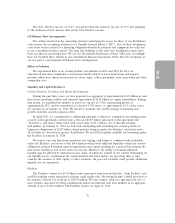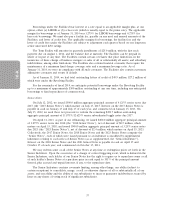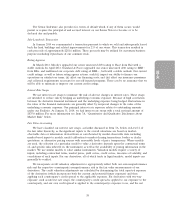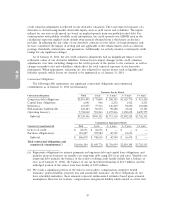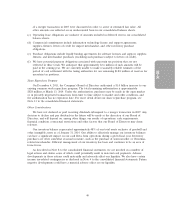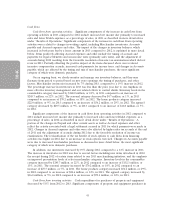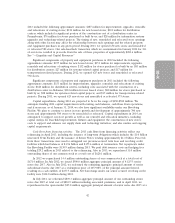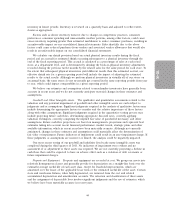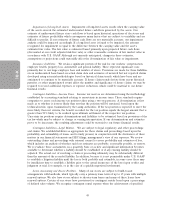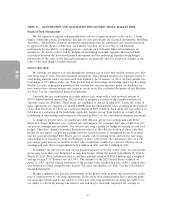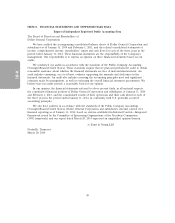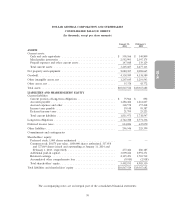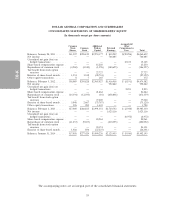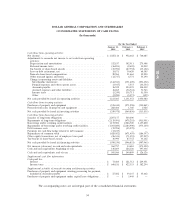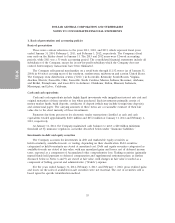Dollar General 2013 Annual Report Download - page 123
Download and view the complete annual report
Please find page 123 of the 2013 Dollar General annual report below. You can navigate through the pages in the report by either clicking on the pages listed below, or by using the keyword search tool below to find specific information within the annual report.
sales targets is considered probable. We record minimum rental expense on a straight-line basis over
the base, non-cancelable lease term commencing on the date that we take physical possession of the
property from the landlord, which normally includes a period prior to store opening to make necessary
leasehold improvements and install store fixtures. When a lease contains a predetermined fixed
escalation of the minimum rent, we recognize the related rent expense on a straight-line basis and
record the difference between the recognized rental expense and the amounts payable under the lease
as deferred rent. Tenant allowances, to the extent received, are recorded as deferred incentive rent and
amortized as a reduction to rent expense over the term of the lease. We reflect as a liability any
difference between the calculated expense and the amounts actually paid. Improvements of leased
properties are amortized over the shorter of the life of the applicable lease term or the estimated
useful life of the asset.
Share-Based Payments. Our share-based stock option awards are valued on an individual grant
basis using the Black-Scholes-Merton closed form option pricing model. We believe that this model
fairly estimates the value of our share-based awards. The application of this valuation model involves
assumptions that are judgmental and highly sensitive in the valuation of stock options, which affects
compensation expense related to these options. These assumptions include the term that the options
are expected to be outstanding, the historical volatility of our stock price, applicable interest rates and
the dividend yield of our stock. Other factors involving judgments that affect the expensing of share-
based payments include estimated forfeiture rates of share-based awards. Historically, these estimates
have not been materially inaccurate; however, if our estimates differ materially from actual experience,
we may be required to record additional expense or reductions of expense, which could be material to
our future financial results.
Fair Value Measurements. Accounting standards for the measurement of fair value of assets and
liabilities establish a fair value hierarchy that distinguishes between market participant assumptions
based on market data obtained from sources independent of the reporting entity (observable inputs
that are classified within Levels 1 and 2 of the hierarchy) and the reporting entity’s own assumptions
about market participant assumptions (unobservable inputs classified within Level 3 of the hierarchy).
Therefore, Level 3 inputs are typically based on an entity’s own assumptions, as there is little, if any,
related market activity, and thus require the use of significant judgment and estimates. Currently, we
have no assets or liabilities that are valued based solely on Level 3 inputs.
Our fair value measurements are primarily associated with our derivative financial instruments,
intangible assets, debt instruments, and to a lesser degree our investments. We use various valuation
models in determining the values of these assets and liabilities. The application of these models
involves assumptions such as discounted cash flow analysis and interest rate curves that are judgmental
and highly sensitive in the fair value computations. In recent years, these methodologies have produced
materially accurate valuations.
Derivative Financial Instruments. In addition to estimating the fair value of derivatives as discussed
above, we also bear the risk that certain derivative instruments that have been designated as hedges
and currently meet the strict hedge accounting requirements may not qualify in the future as ‘‘highly
effective,’’ as defined, as well as the risk that hedged transactions in cash flow hedging relationships
may no longer be considered probable to occur. If hedge accounting were disallowed it could cause
greater volatility in our results of operations. Further, new regulations, accounting standards, and
related interpretations pertaining to these instruments may be issued in the future, and we cannot
predict the possible impact that such requirements may have on our use of derivative instruments.
46
10-K


